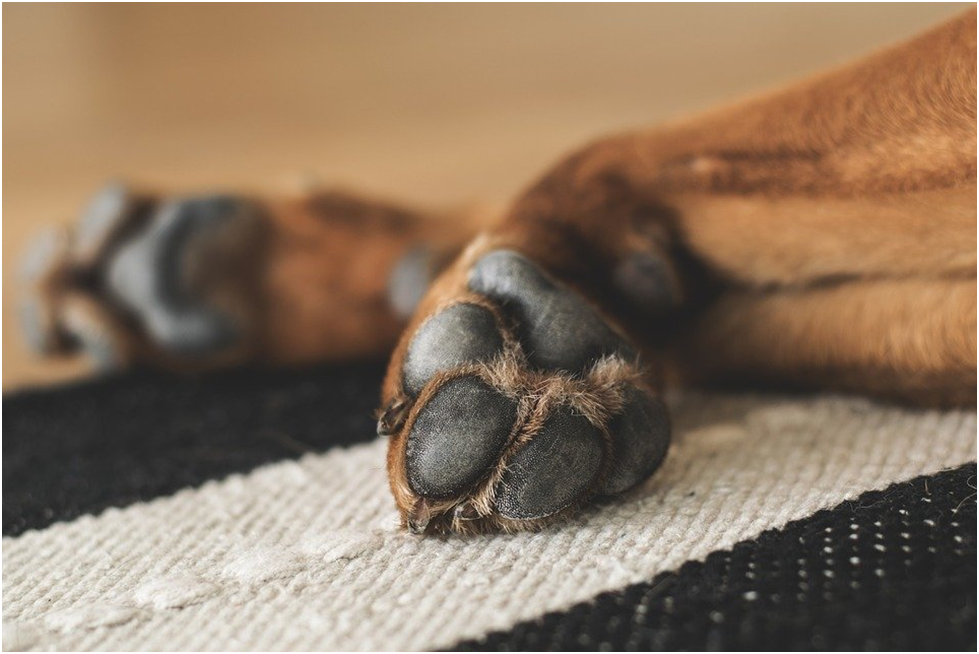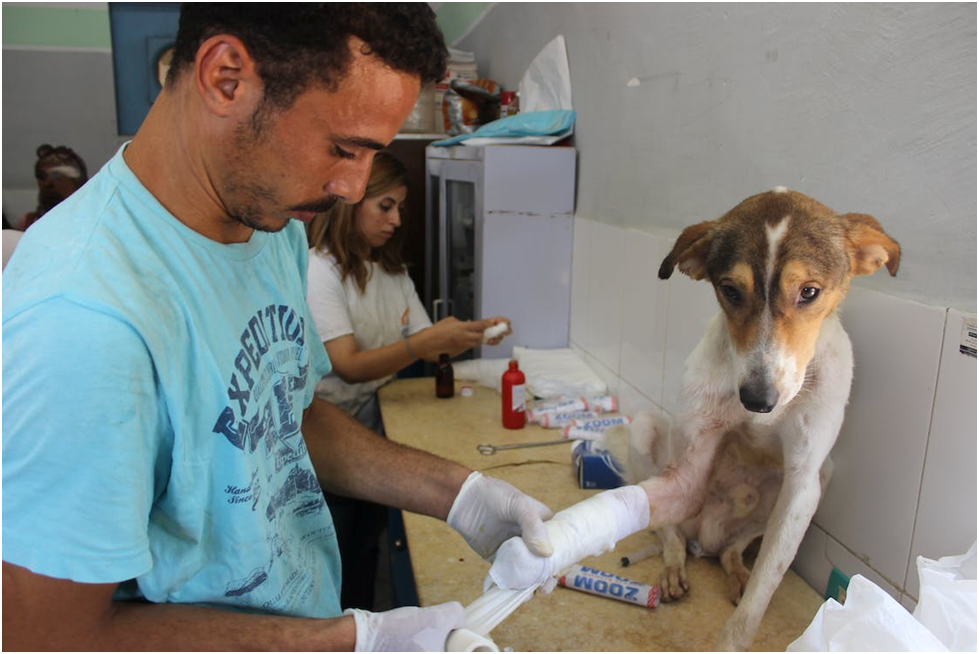Healthy paw pads are critical to the overall well-being of your furry friends. The paw pads bear the dog’s body weight, cushion joints and bones; and help them move around comfortably. So, keeping an eye on your dog’s paws and following a regular care routine is important.
You might see some dogs with pink paw pads or black paw pads. It is also natural for some dogs to have a combination of pink and black paw pads.
A puppy’s paw pads can change color as they are growing up. Likewise, an adult dog’s paw pads can change color due to practices like walking barefoot on hot surfaces or health conditions like allergies and infections.
Knowing what your dog’s paws usually look like and the reasons behind their changing color can help you better care for your pet. Then, in case of health issues, you can seek vet care at the earliest.
Let us get started with dog paw pads, their functionality, color, and care routine.
What Does a Typical Dog Paw Look Like?

A dog paw consists of five main parts – nails, digital pad, metacarpal pad, declaws, and carpal pad.
Each of these paw parts serves a purpose. For example, the cushy digital and metacarpal pads are made from fats and elastic fibers. They protect the tissues inside the paws and also act as shock absorbers cushioning the joints and bones. The thick texture of the pads also protects the paws from uneven and rough surfaces.
Coming to the nails, they help the dog run and maneuver by providing traction. They come in handy when the dog digs. And they also offer some level of stability and protection.
Dogs may or may not have declaws. When your dog is running at high speed, they help the dog with extra traction and provide wrist support.
A typical dog paw should be smooth to touch. If you notice any abrasions, cuts, roughness, shedding, or color changes, it could indicate an underlying issue. Let us see further what these issues can be.
Why Are My Dog’s Paws Pink and Black? 9 Reasons
A dog’s paws can naturally have a light color, or it could be dealing with medical issues. If you notice any other symptoms apart from color changes or skin shedding, please get in touch with the vet.
Here are reasons why your dog’s paws are pink and black.
1. It is the Natural Color of the Paw Pads

Puppies, in general, tend to have cute-looking pink pads with less fur. This is a normal anatomy, so nothing to be worried about. However, as the dog grows, its paws can start turning a darker shade of brown or black.
In some cases, a puppy may not lose all the pink color from its paws. Instead, its paws will have a combination of pink and black colors. You can attribute dual-colored paws to the dog’s genes. The responsible gene makes the dog’s body incapable of producing pigment for the skin and hair.
Such color is common in dogs with mixed color skin. As long as you follow a proper paw care routine, pink or black, your dog should be absolutely fine.
2. The Outer Skin is Growing

Puppies are born with soft plushy pink paw pads. And the paw pads retain their color and texture during the initial months. This is because young puppies do not walk or run around with the same intensity as their older counterparts.
It can take about a month for the puppy to get up and walk and run with a wobbly gait. The time can differ from one breed to another. Even after the puppy reaches 3 to 4 months of age, it should not be made to walk long distances. This is because over-exercising puppies can lead to joint and bone issues.
According to AKC, during the initial months, walking sessions for puppies should be kept short. Even if you have a young large breed dog like a Great Dane, it is not advisable to take them out for 2-mile runs.
Gradually, once the activity level for these puppies rises, the outer skin on their paws will start thickening and changing color. It is like nature’s way of protecting your pet’s paws. As the dog starts going for walks outside, exercising, and playing, it will need that extra protection.
This outer skin will not grow overnight all at once. As the skin thickens, its color will change to a darker shade – almost looking like black. So, until the outer skin grows completely, your dog’s paws will be dual-colored.
3. The Paw Pads are Sensitive
The outer skin on the dog’s paw pads can be shed for several reasons, sensitive skin being one of them. It is possible for the dog to have this condition right from birth.
The pads typically have a tough exterior to protect the dog’s paws. But in some dogs, these paw pads may not be as tough. It may be more sensitive to external conditions like hot and cold weather, walking barefoot on a forest route, or walking on icy-slick roads.
The paw pads can be shed in some places leading to the pink and black appearance. If your dog’s paws are sensitive, it would be best to invest in some high-quality dog shoes, socks, and topicals to protect its paws.
4. It Could be Infections

If your dog spends time outdoors, jumping in the yard, going out for hikes with you, or playing around at the doggy day park, then you need to pay special attention to its paws. There is no need to bathe the dog every time it goes out, but once home, you need to wipe the dog’s paws and ensure no dirt or debris is sticking around.
When outside, the dog could wade into areas with unsanitary conditions. For example, jumping into a water puddle may be fun for the dog, but the water puddle can be a breeding ground for bacteria. So, if you skip the paw-cleaning step, it is an invitation for bacteria to make themselves at home.
The bacteria can fester and lead to infections. Shedding on the outer skin and pink and black paws will be one of the signs you will notice. The infection can spread if the dog already has a cut or wound on its paws. In such a case, you may see additional signs like vomiting, lethargy, diarrhea, licking, and increased thirst.
It would be best to contact the vet as infections need medical treatment and care.
5. Walking on Hot Pavement Roads
Have you seen those videos online where people are frying eggs right on hot pavements? Or the ones where a person’s slippers stick to the pavement because the road is melting due to high temperatures?
What will happen if you and your dog walk across such hot pavements? You both are bound to burn your feet and have blisters on them. Your dog’s paws will shed their outer skin, resulting in pink patches and pain.
This may sound like an extreme scenario, but melting roads are becoming increasingly common in urban cities suffering from heat waves.
Even otherwise, it is best not to let your dog walk barefoot on hot pavements. The temperature may not be soaring, but walking on hot surfaces can contribute to the wear and tear of the paws. In case of blisters, the old skin will peel off to make way for new.
6.Cold Weather Could be Responsible

Similar to hot, cold weather can dry out the skin on the dog’s nose and paws. The dog’s paws can get dry, crack and result in shedding.
Using heaters and lighting up the fireplace will give you the much-needed warmth during those cold, chilly days. But they can also suck the moisture from the air, making the house’s environment dry.
If your dog prefers to stay booted near the heater or the fireplace, its skin can get extremely dry, leading to the ink and black pads.
7. It Could be Allergies
Dogs can be allergic to food and several other environmental allergens. When the dog comes into contact with any such allergen, its body will trigger a reaction. As a result, the dog’s skin can become itchy and irritating. It will excessively scratch or lick the area to soothe the irritation.
This area could be your dog’s paws as well. When licked and gnawed at repeatedly, the pet can end up hurting its paws, resulting in pink patches.
In case of allergies, you may notice other symptoms like vomiting, diarrhea, skin irritation, loss of appetite, or lethargy. It would be wise to contact the vet as allergies need medical treatment. Once the allergy is treated and the symptoms subside, your dog’s paws will eventually return to normal.
8. Exposure to Chemicals

Chemicals have become a part of the modern lifestyle. Our house cleaning products contain chemicals, our skin care products are made from chemicals, and yard maintenance requires chemical fertilizers and pesticides. Not all chemicals are bad.
But, when it comes to canines, some chemicals that humans may fare well in the presence of may be harmful or even toxic for dogs. So, if your dog is exposed to such an irritating or harmful chemical, pink and black paws are one of the many signs you may see.
Thus, if you have a pet at home, look for pet-safe cleaning products. If you spray pesticides on your yard, ensure the dog does not prance around the yard the moment you are done.
Avoid using human skin care products on dogs. For example, using moisturizers meant for humans on a dog’s cracked paw may worsen the situation.
Also, during winters, ensure the dog’s paws are adequately protected because the roads can be laden with salt and ice-melting chemicals.
9. It Could be Compulsive Behavior
It is rare for dogs to be diagnosed with OCD, but it can be a probable cause of your dog’s pink and black paws.
There is no specific cause for the condition, but several contributing factors exist. For example, if the dog does not get enough exercise, is not mentally stimulated enough, and is left alone for most parts of the day, the dog can indulge in destructive behavior.
One such behavior could be excessive licking or scratching. If not deterred and trained to use their energies otherwise, the dog’s behavior may turn compulsive for the dog. In addition, the constant friction to the paws can result in cuts, wounds, and shedding of the outer layer.
This is again a condition that requires the help of a vet and a behaviorist.
What to Do When My Dog’s Paw Pads Change Color?

If dogs with pink paw pads are in their growing phase, then the change of color should not be alarming. The paws are going through their natural route of growth.
If you notice that your adult dog has big patches of pink on its black paws, with noticeable shedding, then the cause needs to be investigated.
In case of allergies and infection, you will also see other physical and behavioral changes in the dog. The vet may prescribe antibiotics, drugs, and topicals to treat the condition.
If the paw pads have become too cracked or have blisters on them, it will again require vet care. The area may be bandaged to aid healing, and the vet may prescribe pain medications.
It is normal for the dog’s paw pads to peel. There will be minimal shedding to make way for new skin. But if the shedding has reached a level where you see visible patches, please visit the vet.
How Should I Care for My Dog’s Paw Pads?

Let us look at some PetMD recommended paw care tips that can save your pet from discomfort, pain, and a visit to the vet.
It is important you give a physical once-over to the dog regularly. This includes the dog’s paw pads. If any dirt, stones, or weeds are stuck in the paws, you can remove them with the help of tweezers. Once the dirt is removed, you can gently clean the area with a moist cloth. Clean paws can also keep allergies and infections away.
In terms of grooming, ensure the dog’s nails are trimmed regularly. If your dog is sensitive about this grooming process, consider taking it to a professional groomer.
Follow seasonal care practices. For example, ensure the dog has appropriate shoes during extreme summer and winter months. When the skin gets dry during cold months, use a pet-specific moisturizer. Avoid walking on hot asphalt and icy-cold roads.
If the dog has a paw injury, tend to it with an anti-bacterial solution. Bandage the area to prevent the entry of dirt and bacteria. If the wound is big, please visit the vet.
Summary
Dogs with pink paw pads? Is this natural or something to be worried about?
It is natural for newborn puppies to have soft pink paw pads. As the puppy grows, becomes active, and starts moving around, the natural process will kick in, and the outer skin of paw pads will start thickening, resulting in the dual-color pads.
Some dogs may retain the dual color due to genes that make them incapable of producing pigment.
In adult dogs, their outer skin can shed for reasons like hot and cold weather, allergies, infections, or compulsive behaviors. Some shedding is considered normal, but if you see big pink patches on your dog’s paws, it would be best to reach out to the vet.
Heather Abraham is a professional blogger who owns two dogs, a cat, a parrot, and a leopard gecko. She has a connection with animals since she was a child. She shares her love for all pet breeds and provides information on pet food, toys, medications, beds, and everything else.
She is committed to learning about the internal workings of animals. Her work permits her to work closely with knowledgeable vets and obtain practical expertise in animal care. When she is not working, her love of animals continues in her writing. Her goal is to educate and uplift readers who also have a passion for animals through her writing.
